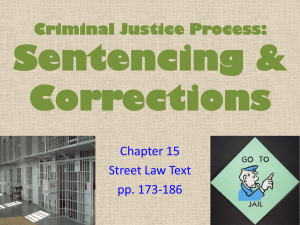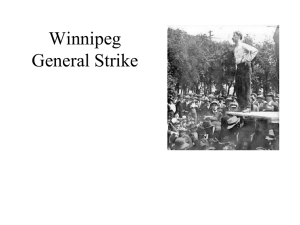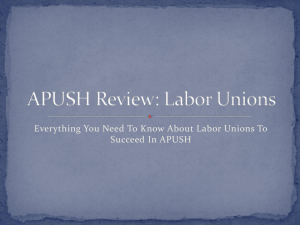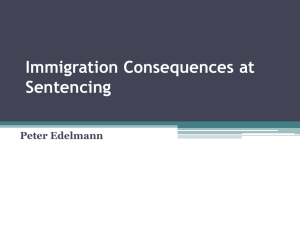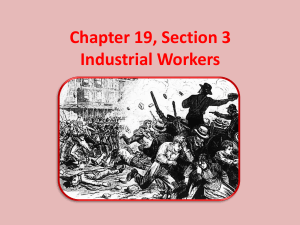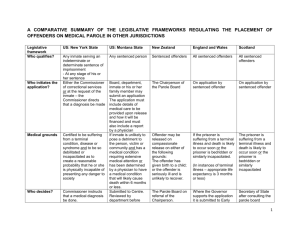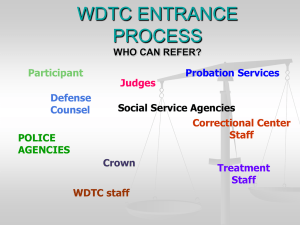Lock `em up & throw away the key
advertisement
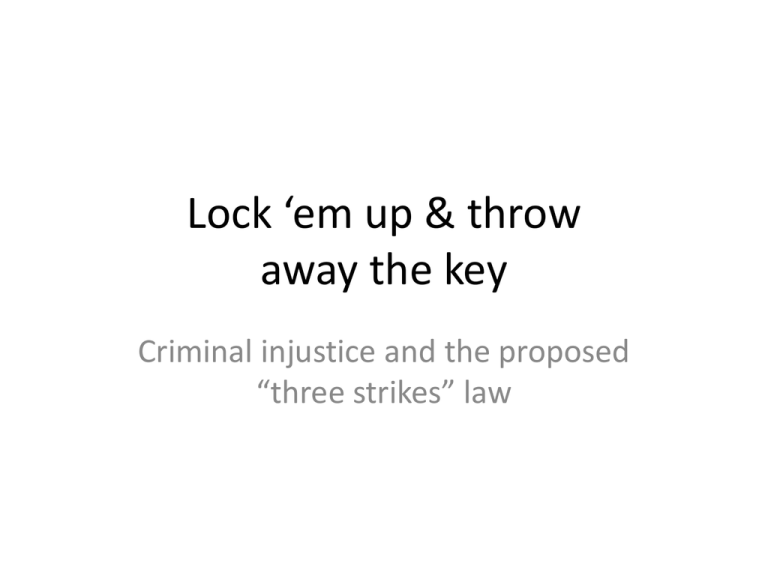
Lock ‘em up & throw away the key Criminal injustice and the proposed “three strikes” law The legislation • Ratcheting up penalties on repeat offenders • 40+ qualifying offences (serious violent crime), including murder, rape, robbery, indecent assault, aggravated burglary • On first conviction, first warning (“strike one”) • Offence after first warning receives final warning (“strike two”) and no parole eligibility • Offence after final warning (“strike three”) receives (a) maximum sentence, (b) no parole The legislation (cont.) • Section 86D: (2) Despite any other enactment, if, on any occasion, an offender is convicted of 1 or more stage-3 offences other than murder, the High Court must sentence the offender to the maximum term of imprisonment prescribed for each offence. (3) When the Court sentences the offender under subsection (2), the Court must order that the offender serve the sentence without parole unless the Court is satisfied that, given the circumstances of the offence and the offender, it would be manifestly unjust to make the order. The legislation (cont.) • ACT Party pamphlet: “The judge sentencing a Strike Three offender will have no option but to sentence the offender to the maximum sentence. The only exception is if the judge determines it would be ‘manifestly unjust’ to do so.” • This is wrong: the judge quite clearly has no discretion in respect of imposing the maximum sentence. In other words, it is mandatory. The legislation (cont.) • If third strike is manslaughter: (a) life sentence and (b) at least 20yr non parole period • Court need not order (b) if manifestly unjust in which case at least 10yr non parole period • An example: robbery (1yr), robbery (4yrs, no parole), aggravated burglary (14yrs, no parole) The legislation (cont.) • For murder, law now is life with at least 10yr non parole period unless manifestly unjust • If murder is second or third strike: life without parole unless manifestly unjust • If manifestly unjust, then either at least 20yrs (if third strike) or 10yrs (if second strike) • Further: strikes do not lapse, no cumulative sentences, life without parole authorised Purposes of sentencing • Retribution is the central purpose – Punish the offender’s wrongful choice – Punishment should be proportionate to wrong – Like cases to be treated alike • Retribution justifies but limits punishment • Other purposes (deterrence, public safety, rehabilitation) are limited by retribution • Public or victim confidence not an end in itself Nature of offences • • • • The legislation purports to be proportionate However, it ignores the variety of criminal acts Robbery: street robbery or bank raid Related offences: robbery, aggravated robbery, burglary, aggravated burglary • Burglary is not a qualifying offence • Many offences do not involve actual violence Nature of offences (cont.) • Not all serious violent offences are included • This focus on violent crime ignores other grave wrongs: drug dealing, fraud, corruption • There is a tendency to treat all sexual and violent crime as if it were worst of worst • Focusing on this class distorts punishment Aggravating factors • Judges should take into account: – – – – – – – – – Abuse of trust or authority Hatred for the victim’s race, religion, etc Participation in organised crime Impact of the offence on the victim Brazen defiance of the law Previous convictions (date, frequency, relevance) Premeditation Particular cruelty in committing the offence Efforts to conceal the offending Mitigating factors • Judges should take into account: – The offender’s limited involvement in the offence – The conduct of the victim – The age of the offender – The offender’s limited intellect or understanding – Previous good character – A plea of guilty, especially an early plea – Evidence of remorse or reparation to victim – Cooperation with the authorities Arbitrariness of the scheme • • • • • The scheme ignores the detail of the wrong Arbitrary to ignore almost all relevant factors Arbitrary to treat criminal history in this way Very different wrongs each count as one strike Prior convictions are relevant, but punishment should still be for this particular crime Arbitrariness of the scheme (cont.) • Unjust outcomes are likely: – Much harsher punishment for same offence on second and third strike – Much harsher punishment for less serious offence on third strike than for more serious on second – Identical punishment for offences of very different gravity on third strike • Ringleader (who is violent, cruel) may be punished less than others (who plead guilty) Examples of injustice • Set aside second strike consequences • Assume two relatively minor qualifying convictions: indecent assault (drunken grope), wounding with intent (pub brawl) or robbery (unplanned street robbery, no violence) • Final warning may have been many years ago • Now consider the third strike consequence Example one • An indecent assault conviction (drunken grope) receives 7yrs, no parole • This may be more than for rape (if guilty plea) Example two • An unplanned street robbery (no violence) receives 10yrs, no parole • This would be to treat this offence as if it were as bad as (or worse than) a vicious, violent invasion of someone’s home or business Example three • A street robbery by two persons (an aggravated robbery), with no violence receives 14yrs, no parole • But for this scheme, up to 3yrs would be likely • The offence is much less serious than a violent, premeditated armed robbery Example four • Breaking into an empty warehouse with a knife or crowbar (aggravated burglary), no violence used, receives 14yrs, no parole • This is to treat the offence as equivalent to a very violent armed robbery or kidnapping Example five • The courts recognise three variants of GBH, depending on context and injuries inflicted • Imagine a woman who in a rage seriously assaults the man who has abused her children • She receives 14yrs, no parole, just as if she were a mob enforcer who beats a witness half to death to corrupt a trial Manslaughter • Manslaughter covers a very wide range of acts: assaults causing death, accidents, etc • Imagine a mechanic who negligently repairs a car’s brakes, leading to the death of the driver • He receives life, with at least 20yrs non parole • The judge will certainly reduce this to 10yrs, but this is still no different to murder • It is perverse to sentence him as if a murderer Murder • The scheme makes a life sentence mandatory • For some murders, judges would otherwise conclude this was manifestly unjust: ‘mercy killing’, provocation, excessive self-defence • If unjust to impose life for this crime, previous convictions do not change this • Very many first-strike murders are worse than second or third strike murders The scope of the proposal • Initial proposal targeting “the worst of the worst” • Counting as a strike a sentence of +5yrs imprisonment for qualifying offence • Current proposal counting as strike only a conviction for qualifying offence • Shift to qualifying conviction radically widens the scope of the legislation The deterrence rationale • General deterrence – punishing offender to deter others • Declaratory power of criminal justice system • Doubling sentence does not double deterrent effect • Individual deterrence – punishing offender to deter him /her from future crime • Whether judicial warnings are an effective deterrent Parole and incapacitation • Sending message parole a privilege not a right • No need to abolish parole to send that message • Impossible to prevent all offending on release • Impact of removal of parole on prisoners and guards • Benefits of parole – aids rehabilitation • Increase eligibility to 2/3 of nominal sentence Impacts on trial process • • • • • Inevitability of more defended hearings Removal of incentive to plead guilty No encouragement for remorse Shift in significance of prosecutor’s discretion Shift of discretionary powers to executive branch • Risk of further compounding of arbitrary sentences Costs and alternatives • Significant operating and capital costs of 3 strikes • Problem of aging prisoners in jails • Burden to CJ system of increase in defended hearings • Alternative uses for funding, including victim support and speedier resolution of cases • Increased use of existing sentences Conclusion • The punishment should fit the crime • However, mandatory sentencing ignores the wrong and will do injustice in many cases • The deterrent impact is likely to be limited • It is unwise to abolish parole altogether • We should look for reforms that enable just punishment and do not destroy hope
